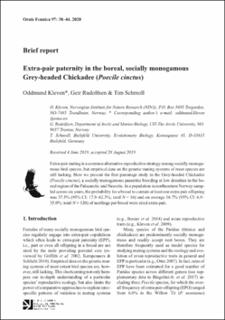| dc.contributor.author | Kleven, Oddmund | |
| dc.contributor.author | Rudolfsen, Geir | |
| dc.contributor.author | Schmoll, Tim | |
| dc.coverage.spatial | Eastern Norwway | en_US |
| dc.date.accessioned | 2021-01-25T14:15:24Z | |
| dc.date.available | 2021-01-25T14:15:24Z | |
| dc.date.issued | 2020 | |
| dc.identifier.issn | 0030-5685 | |
| dc.identifier.uri | https://hdl.handle.net/11250/2724601 | |
| dc.description.abstract | Extra-pair mating is common alternative reproductive strategyamong socially monogamous bird species, but empirical data on the genetic mating systems of most species are still lacking. Here we present the first parentage study in the Grey-headed Chickadee (Poecile cinctus), a socially monogamous passerine breeding at low densities in the boreal region of the Palaearctic and Nearctic. In a population in northeastern Norway sampled acrosssix years,the probability for abrood to contain at least one extra-pair offspring was 37.5% (95% CI: 17.9–62.3%; total N = 16) and on average 16.7% (95% CI: 6.9– 35.0%; total N = 120) of nestlings per brood were sired extra-pair. | en_US |
| dc.language.iso | eng | en_US |
| dc.title | Extra-pair paternity in the boreal, socially monogamous Grey-headed Chickadee (Poecile cinctus) | en_US |
| dc.type | Peer reviewed | en_US |
| dc.type | Journal article | en_US |
| dc.description.version | publishedVersion | en_US |
| dc.subject.nsi | VDP::Matematikk og Naturvitenskap: 400::Zoologiske og botaniske fag: 480 | en_US |
| dc.source.pagenumber | 38-44 | en_US |
| dc.source.volume | 97 | en_US |
| dc.source.journal | Ornis Fennica | en_US |
| dc.identifier.cristin | 1799539 | |
